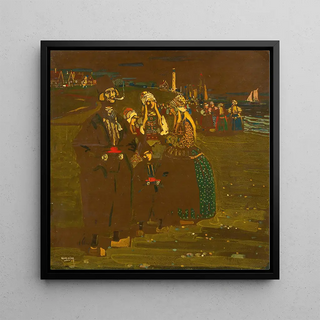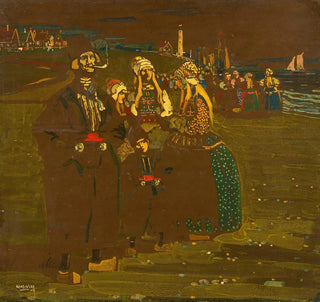Souvenir of Holland awaiting returning ships - Wassily Kandinsky

The reinvented sea: Wassily Kandinsky's poetic palette in Holland Souvenir awaiting returning ships
In this composition, Kandinsky transforms the port scene into a ballet of shapes and colors: cut horizons, sketched ship silhouettes, and luminous touches rhythmically filling the space. The palette blends marine tones with warm accents, creating an atmosphere that is both contemplative and vibrant, where geometry suggests the movement of waves and wind. The technique, on the threshold of emerging abstraction, favors formal simplification to better express pure visual emotion. This art print Holland Souvenir awaiting returning ships captures the tension and delicacy of the original.
Wassily Kandinsky, master of the transition to abstraction
Russian painter and theorist Wassily Kandinsky played a central role in the evolution of modern art in the early 20th century. Influenced by symbolism and Russian pictorial traditions, then by German avant-gardes, he gradually developed a formal language liberated from figuration, exploring the relationship between color, form, and emotion. Founder of key ideas on synesthesia and the spirituality of painting, he marked movements like the Blue Rider and inspired many artists. The art print Holland Souvenir awaiting returning ships illustrates this transitional period, combining structure and visual poetry with surprising readability.
A decorative acquisition with multiple assets
Adopting this Holland Souvenir canvas awaiting returning ships for your interior is choosing a piece that dialogues with different styles: contemporary living room, creative office, or elegant bedroom. The art print is created with chromatic fidelity and textured rendering designed to preserve the depth of the original while adapting to modern formats. It brings a measured artistic presence, capable of enlivening a wall without imposing itself. Whether to punctuate a gallery wall or to become the focal point of a room, this painting invites repeated gazes and reflection, offering a balance between decorative elegance and artistic rigor.

The reinvented sea: Wassily Kandinsky's poetic palette in Holland Souvenir awaiting returning ships
In this composition, Kandinsky transforms the port scene into a ballet of shapes and colors: cut horizons, sketched ship silhouettes, and luminous touches rhythmically filling the space. The palette blends marine tones with warm accents, creating an atmosphere that is both contemplative and vibrant, where geometry suggests the movement of waves and wind. The technique, on the threshold of emerging abstraction, favors formal simplification to better express pure visual emotion. This art print Holland Souvenir awaiting returning ships captures the tension and delicacy of the original.
Wassily Kandinsky, master of the transition to abstraction
Russian painter and theorist Wassily Kandinsky played a central role in the evolution of modern art in the early 20th century. Influenced by symbolism and Russian pictorial traditions, then by German avant-gardes, he gradually developed a formal language liberated from figuration, exploring the relationship between color, form, and emotion. Founder of key ideas on synesthesia and the spirituality of painting, he marked movements like the Blue Rider and inspired many artists. The art print Holland Souvenir awaiting returning ships illustrates this transitional period, combining structure and visual poetry with surprising readability.
A decorative acquisition with multiple assets
Adopting this Holland Souvenir canvas awaiting returning ships for your interior is choosing a piece that dialogues with different styles: contemporary living room, creative office, or elegant bedroom. The art print is created with chromatic fidelity and textured rendering designed to preserve the depth of the original while adapting to modern formats. It brings a measured artistic presence, capable of enlivening a wall without imposing itself. Whether to punctuate a gallery wall or to become the focal point of a room, this painting invites repeated gazes and reflection, offering a balance between decorative elegance and artistic rigor.





